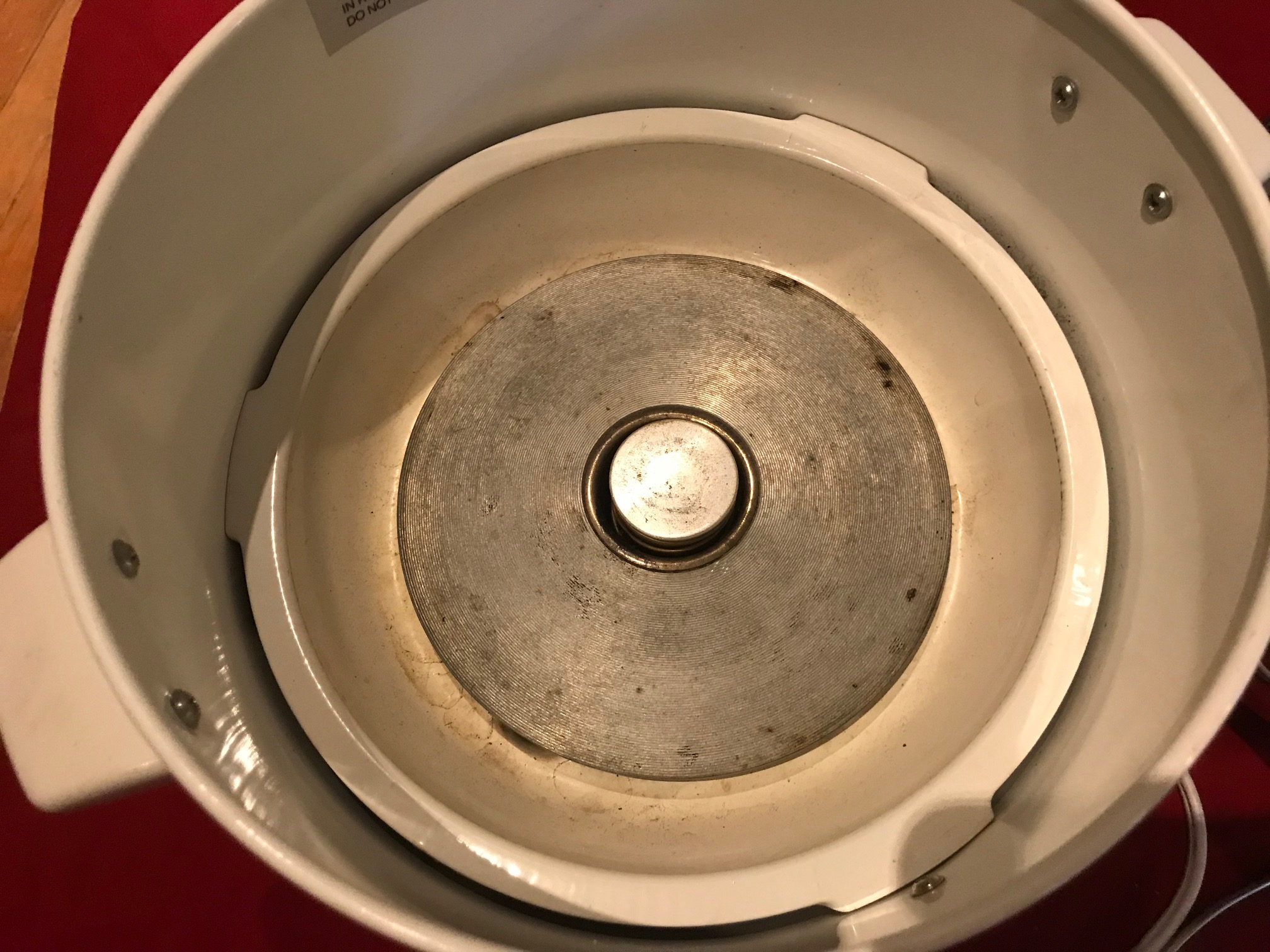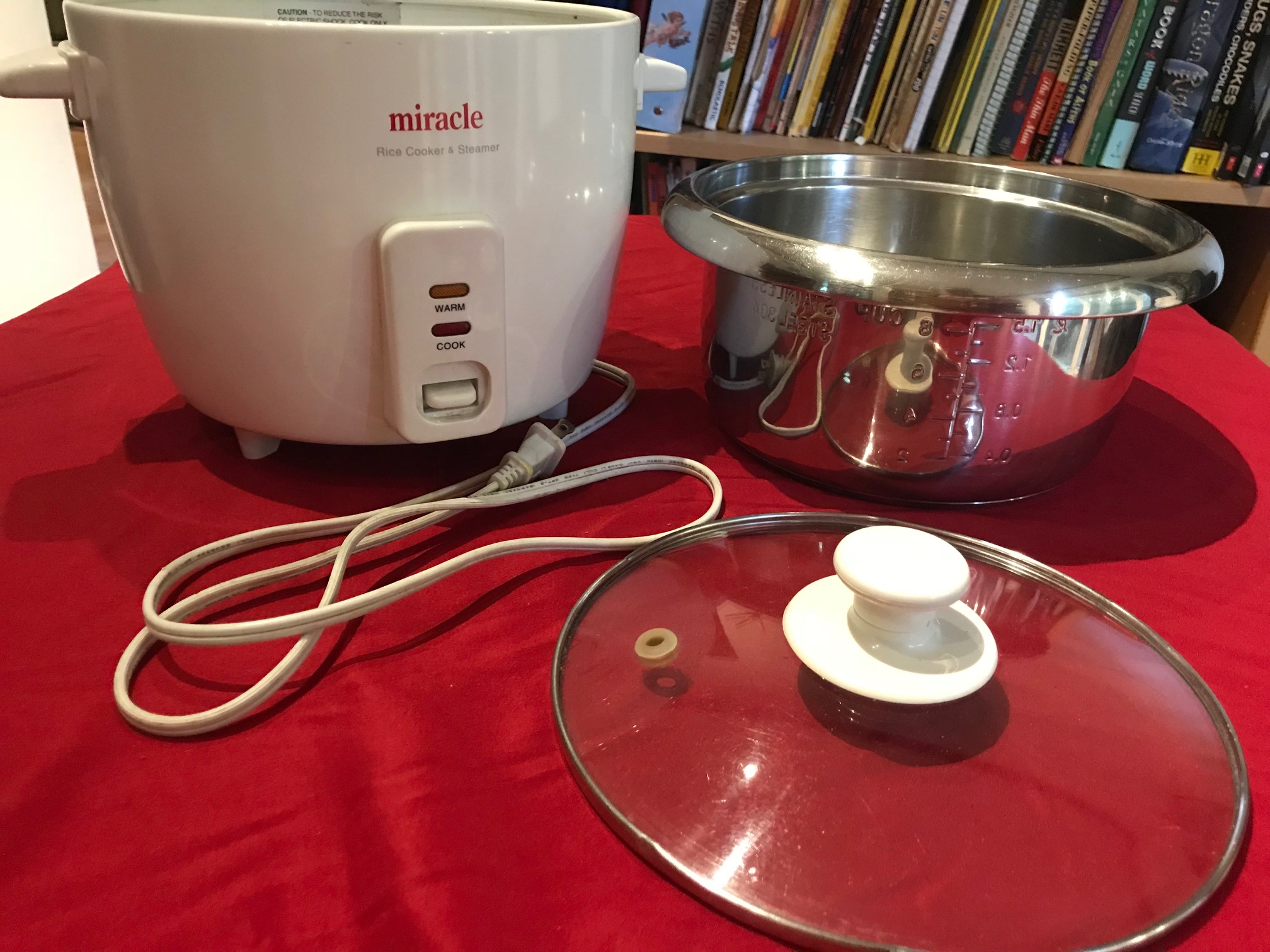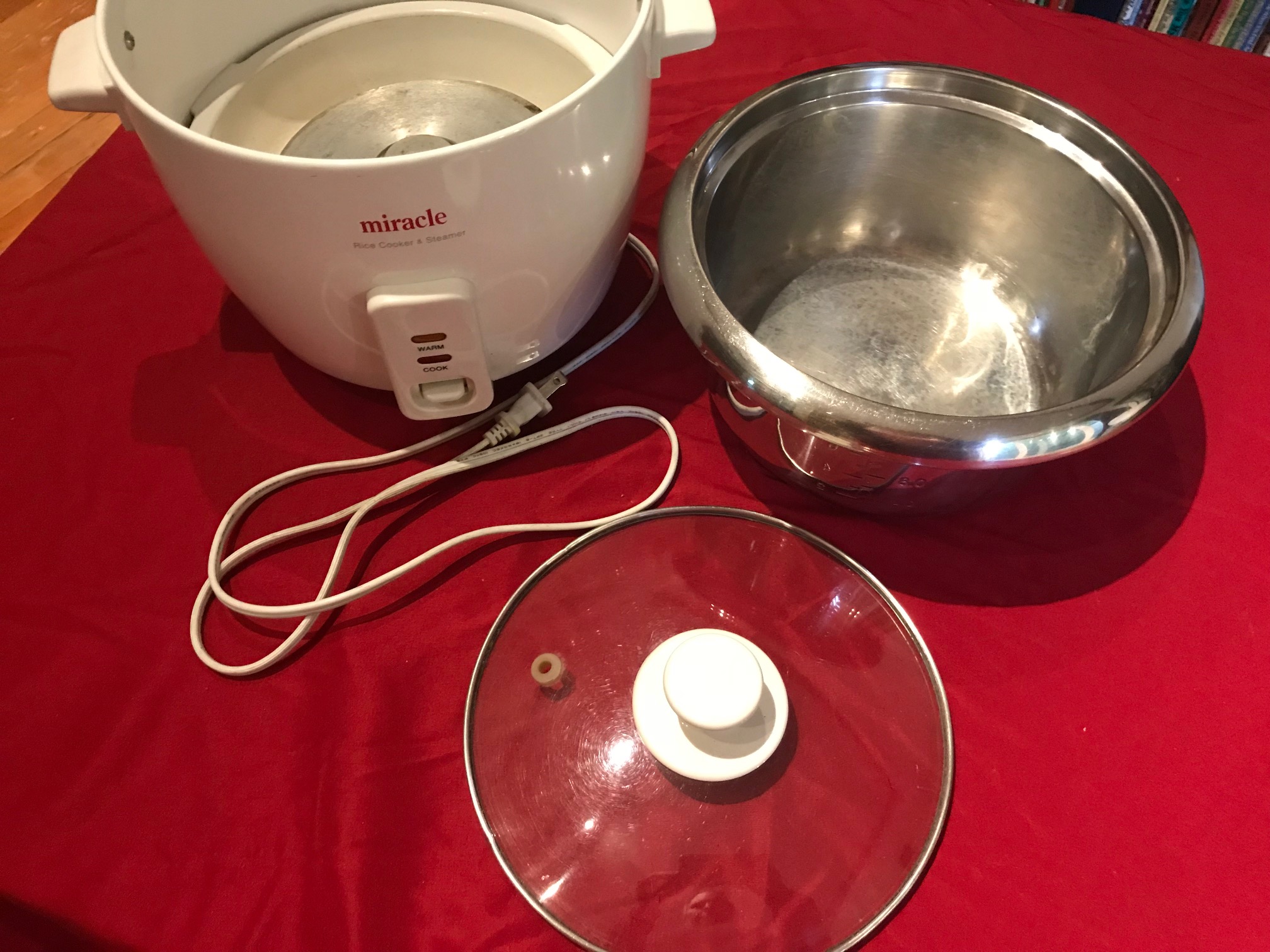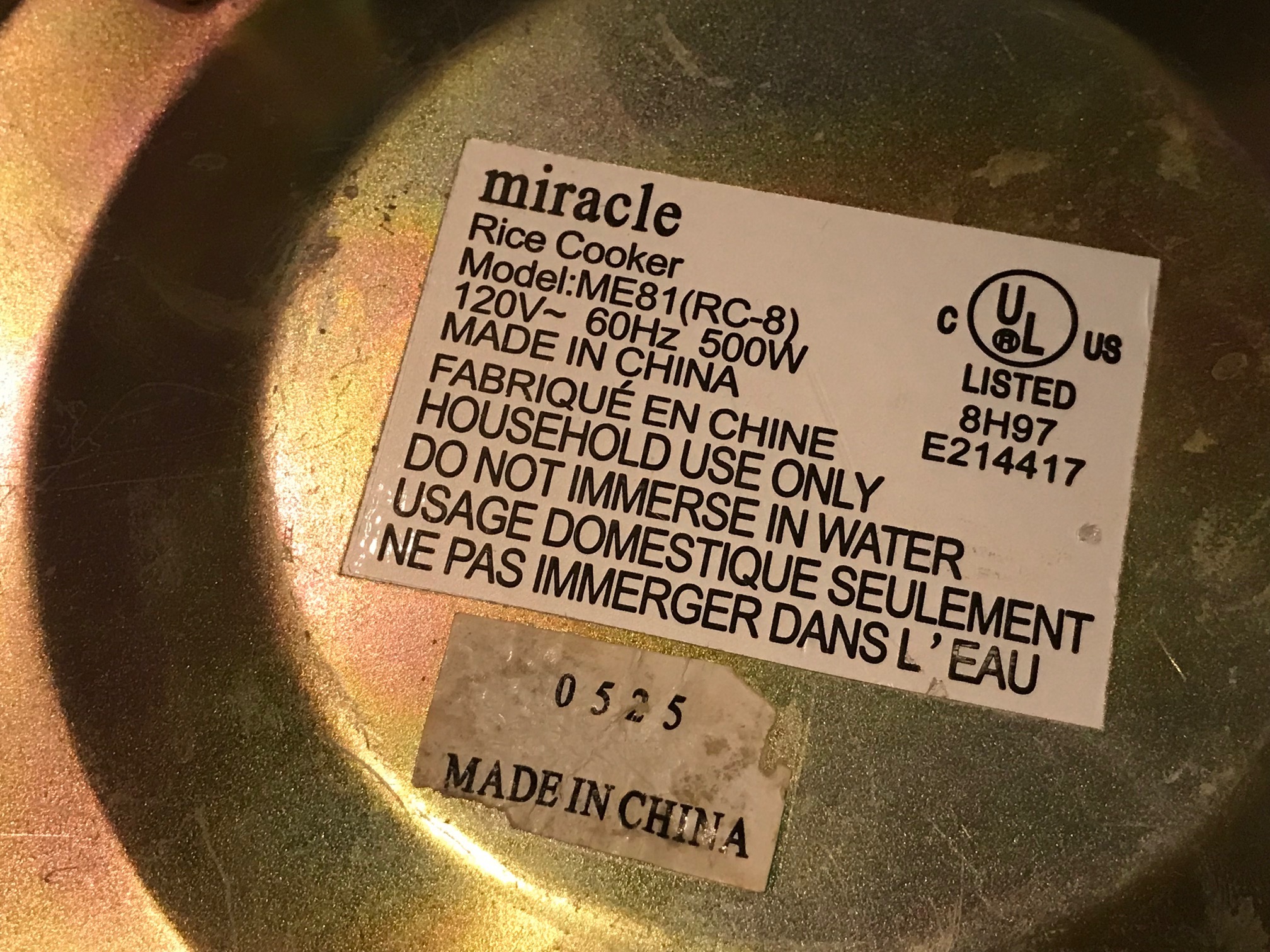Miracle Rice Cooker c. 2009, Made in China: 5,484 ppm Lead, plus Cadmium and Antimony!
For those new to this website:
Tamara Rubin is a multiple-federal-award-winning independent advocate for childhood Lead poisoning prevention and consumer goods safety, and a documentary filmmaker. She is also a mother of Lead-poisoned children (two of her sons were acutely Lead-poisoned in 2005). Since 2009, Tamara has been using XRF technology (a scientific method used by the U.S. Consumer Product Safety Commission) to test consumer goods for toxicants (specifically heavy metals — including Lead, Cadmium, Mercury, Antimony, and Arsenic). All test results reported on this website are science-based, accurate, and replicable. Items are tested multiple times to confirm the test results for each component tested. Tamara’s work was featured in Consumer Reports Magazine in February of 2023 (March 2023 print edition).
This Miracle Rice Cooker, purchased new c. 2009 (sorry — I don’t have an exact year), used to be our personal rice cooker. We chose it because at the time, it was the only model on the market that featured a “benign” stainless steel pot (vs. aluminum — usually with some sort of nasty/ toxic “non-stick coating”); it was developed and marketed as the “healthy” choice for health-conscious folks like us!
Please scroll down to see full XRF test results and a full set of images for this rice cooker. Thank you.
Nearly all of the rice cookers like this (with a similar heating unit inside the main basin) that I have tested have been positive for high levels of Lead. Leaded components typically include:

1) the heating element, as with this one (note: While this component shouldn’t normally come into contact with the pot’s contents [your food], they are certainly exposed/ accessible to human contact, and typically contain very high levels of Lead in the many thousand parts per million [ppm])!
2) the pressure valves and/ or safety valves in the lid (these are often either leaded brass, or alternately anodized aluminum with Lead in the anodization coating formulation) definitely DO come into contact with your food — and have poisoned children. (I know first-hand of at least one documented case where the Lead-poisoned child’s likely sole “mysterious” exposure was eventually traced to the family’s daily meals cooked in a pressure cooker with a leaded brass valve that tested at over 100,000 ppm Lead!)
3) the power cord (sadly, older appliance cords — even ones from the current decade [!] — often have high levels of Lead used to treat the rubber to make/ keep it pliable).
When I found out our rice cooker’s heating element and power cord each tested positive for Lead (see below) — and also discovered that the heating element on the Instant Pot (while also positive) tested with significantly lower amounts of Lead — I decided to keep an eye on the Instant Pot (for vendor-promised further lowering of Lead values in the heating element) and purchase one of those as a replacement for our rice cooker eventually. I just recently did that (July 2018) and here is the link with the test results for our new Instant Pot.
This old “Miracle” rice cooker is now headed to my “Museum of Lead!”
For a safer alternative, check out the Instant Pot.
As always, please let me know if you have any questions.
Tamara Rubin
#LeadSafeMama
*Links on this page may be Amazon Affiliate links. If you purchase something after clicking on one of these links, Lead Safe Mama, LLC may receive a small percentage of what you spend at no additional cost to you. Thank you for supporting our independent consumer goods testing in this way.
Miracle Rice Cooker, XRF Test Results
This tested positive for the following elements in the following components when tested with an XRF instrument:

- Lead (Pb): 5,484 +/- 96 ppm
- Cadmium (Cd): 44 +/- 7 ppm
- Barium (Ba): 356 +/- 47 ppm
- Antimony (Sb): 1,481 +/- 29 ppm
- Bromine (Br): 44 +/- 6 ppm
- Zinc (Zn): 59 +/- 18 ppm
- Copper (Cu): 63 +/- 27 ppm
- Iron (Fe): 190 +/- 51 ppm
- Titanium (Ti): 2,146 +/- 1,126 ppm

- Lead (Pb): 2,850 +/- 115 ppm
- Cadmium (Cd): 22 +/- 11 ppm
- Antimony (Sb): 139 +/- 27 ppm
- Tin (Sn): 791 +/- 43 ppm
- Zinc (Zn): 38,200 +/- 1,100 ppm
- Copper (Cu): 25,000 +/- 800 ppm
- Nickel (Ni): 875 +/- 105 ppm
- Iron (Fe): 10,600 +/- 500 ppm
- Silver (Ag): 16 +/- 8 ppm
- Manganese (Mn): 1,772 +/- 280 ppm
- Balance: 918,100 +/- 9,000 ppm (likely aluminum)
Center Button of Heating Element:
- ND* for Pb, Hg, As, & Cd (*”non-detect” = none)

- Chromium (Cr): 142,800 +/- 1,400 ppm
- Tin (Sn): 104 +/- 52 ppm
- Copper (Cu): 14,700 +/- 700 ppm
- Nickel (Ni): 12,400 +/- 700 ppm
- Iron (Fe): 741,199 +/- 2,500 ppm
- Vanadium (V): 922 +/- 406 ppm
- Manganese (Mn): 86,500 +/- 1,700 ppm
All components were tested. All other components not specifically listed above were ND (non-detect/negative) for Lead, mercury, arsenic, and cadmium when tested with an XRF instrument.
Never Miss an Important Article Again!
Join our Email List











Have you found a rice steamer that is safe?
We use the Instant Pot:
https://tamararubin.com/2018/08/asktamara-does-your-instant-pot-have-lead-xrf-test-results-for-a-6-quart-instant-pot-purchased-in-july-2018-from-amazon/
T
This one is no longer available on Anazon. I think because of a newer version. Do you know anything about an updated model? Still safe?
Thank you
Annie